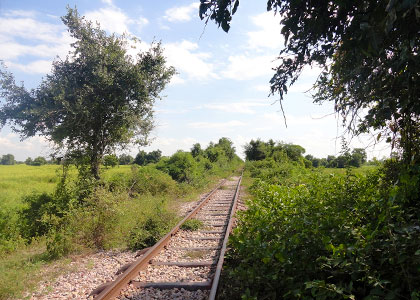How to Take Bamboo Trains in Cambodia
Train services in the South-East Asian country of Cambodia are taking their baby steps, with trains running up and down on only one established route. However, in some rural areas of the country, there runs a train that the locals refer to as the “norry”, which originally was a play on “lorry”, a European word. This train has gained popularity all around the world as the bamboo train of Cambodia.For many Cambodian locals, this train is an easy means of commute in some of the country’s most remote areas. For travellers and tourists, it offers a glimpse into a mode of transport that has been common in Cambodia much before modern trains came into existence in the country.
The Origins of the Bamboo Train in Cambodia
The reign of the Khmer Rouge in Cambodia is not something that the locals would like to recall. However, that is the dark and cloudy period during which the bamboo train was something of a silver lining.To stop Cambodia from descending into complete chaos, the United Nations stepped in. They formed the United Nations Transitional Authority of Cambodia (UNTAC), who sought to oversee a peaceful transition of the nation after the fall of the Khmer Rouge. During this time, the now-famous bamboo train of Cambodia was invented. The main objective of these trains was quite simple; supply goods in the villages situated along the northern train line.
|
|
|
How the Train Works
• The bamboo train in Cambodia features heavy wheels and axles. These parts are generally taken from old tanks and trucks.
• Once the base of the body is made, it is covered with bamboo slats.
• A motor is attached to the body and a large rubber band is slipped through the motor and over the rear axle.
• The wheels are set in motion when the driver pushes the rear axle away from the motor by using a stick.
• For applying brakes and bringing the train to a halt, the stick is used to push the rear axle towards the motor.
• The fastest speed of a bamboo train in Cambodia is around 50km (31mi) per hour.
• The trains run on a single track.
• If two trains arrive from opposite directions, the train with the lighter cargo has to be disassembled to make way for the train with the heavier cargo.
Where the Train Runs
While bamboo trains are privately used by numerous villagers who reside close to existing railroads, there is a specific route that is meant primarily for tourists. This route is located in the province of Battambang.The train sets off for the journey from a village called Sang in the Kanteu II commune and terminates at the Chhoeuteal commune. The total one-way journey is just over 5km and tourists need to pay $5 for a highly enjoyable one-way ride. The bamboo trains are perfect for an up, close and personal look at the lush green Cambodian countryside. They also offer glimpses into the hard lives of villagers residing close to the railroad.
Read More: Cambodia Trains - Popular Routes & How to Buy Tickets
Why Bamboo Trains Mean More than Just Tourism to Locals

Tourists Experience the Bamboo Train
|
So far, these trains offer cost-effective means of transporting goods and supplies to and from villages in Cambodia’s rural areas. The trains offer benefits in particular to farmers, especially those whose rice fields are located far from their homes.
The bamboo trains also play a role in the cultural scheme of things in the country. During weddings and festivities in the villages, one can see the trains all colourful and decorated, ready to transport people from one location to another.
The Cambodian Bamboo Trains Face the Threat of Extinction
In recent years, the authorities have been hell-bent on developing the railroads to suit modern trains. Steps taken in this regard have come at a cost for the villagers, who have been forced to adapt and adjust. For years, bamboo trains have served as their lifelines, benefiting them on both financial and social levels. However, the shift towards operating modern trains on the railroads threatens to completely wipe out a unique travel culture.There are high chances of the bamboo trains slowly disappearing from the face of Cambodia. While Cambodian authorities understand the importance of the trains for the locals, they believe that modern trains will be able to transport not just a greater amount of goods, but also a far greater number of tourists. Every year, Cambodia is seeing more and more tourists, who want to visit the ruins of famous temples in the country’s rural regions.
According to estimates calculated by the Asian Development Bank (ADB), over 1100 families will be affected financially if the bamboo trains go out of business. Even though the ADB has promised restitution funds for the people who will be affected financially, things don’t look very promising.
From a completely bureaucratic perspective, the majority of norry drivers are deemed ineligible for compensation. The ones who have already been put out of business due to development have not received what they had been promised, which signals danger for the ones who are still operating.
No one’s quite sure about the future of Cambodia bamboo trains. So, if you are someone who wants to get close to the rural culture and people of Cambodia, you should go for a bamboo train experience sooner rather than later.


